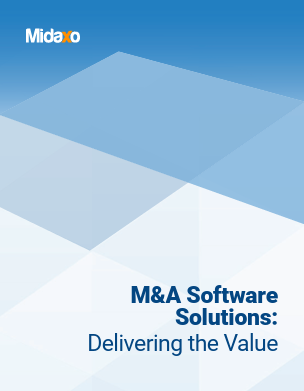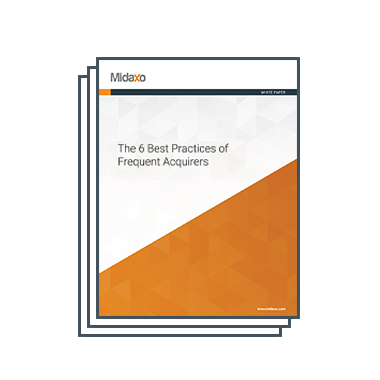Introduction:
Galina Wolinetz boasts over 25 years of industry experience, specifically in Corporate Development roles. She is currently a critical member of Virtas Partners, serving as its Managing Director.
In a recent Live Q&A with Midaxo, Wolinetz leveraged her expertise to offer insights into commonly asked questions regarding roll-ups. We’ve summarized some of the popular questions and her answers below.
Quick Background: what is a roll-up strategy?
A roll-up strategy is when a company embarks on an acquisition of similarly sized, similar industry companies with the aim of bringing them together. The acquirers believe they can draw value by having all of the identified smaller companies come together under one umbrella then taking advantage of business synergies. We see roll-ups with dental offices, engineering firms, veterinary clinics, plumbing companies…the list goes on.
Wolinetz notes two key phases of roll-ups:
- Phase1: programmed set-up; done before you sign the first LOI for the first acquisition in the roll-up; Here you develop the robust deal thesis & identify your integration team and leader.
- Phase 2: the actual acquisitions; integration begins during due diligence, if not earlier; maintain continuity between due diligence, integration, and post-close.
Question 1: What is a typical integration process for roll-ups?
First, Wolinetz sits down with the management team of the company doing the roll-up and defines the integration thesis (also known as the integration hypothesis). The development of the integration thesis allows Wolinetz and her team to help the acquirer create an overarching plan of how to take advantage of synergies and how uniform the companies will be. From here, she works to develop a work-plan based on a playbook. Considerations for the acquirer include: How do we integrate what we want? How will we operate with the sellers? What type of legacy do we hope to leave with the sellers and employees?
Once the above is laid out, typical integration plans begin such as planning for Day 1 and communication with customers and employees. There must be a heavy focus on culture because the companies acquired in the roll-up will all have their own unique cultures.
Question 2: How do you ensure the strategy is understood across all functional areas?
To begin, understand what functional resources you have as the acquirer and if any supplements are needed. Then, think about the team: the integration team and the governance structure. You will want to have a session with the integration team to make sure it understands the deal thesis, objectives, and where it will draw synergies from. This is quite important as success will stem from a deep understanding of the deal thesis.
Question 3: In this hybrid post-pandemic world, what are some issues you are seeing related to integration?
Of course, pre-2020 everything was in person, as Zoom was not a tool consistently leveraged by the average person. The benefits of meeting in person are numerous, namely, getting to know each other on multiple levels by going to dinner, etc., which helps walls breakdown and information flow more freely. Throughout the pandemic, all processes were converted to virtual processes, which has also proven to be a very good option. Just as there are pros associated with being in person, there are also pros associated with going virtual, such as reduced cost and less time wasted on travel. As a result of the obvious positives of both in person and virtual, the future will most likely be a hybrid of the two so we must ask ourselves, how do we manage having some people in person and some on Zoom?
Question 4: Which is better, to fully integrate or keep a company as a stand alone? How do you determine the level of integration?
The level of integration depends on what you are hoping to achieve as an acquirer, as well as your capabilities and level of experience. If you are truly a hands-on person with expertise and you see a significant number of synergies ready to capture, you should integrate fully or at least more fully. On the other hand, if you are a financial buyer, then maybe limited integration is better. Other factors to consider: the industry involved and the competition.
Question 5: What are the top hurdles in executing a successful roll-up?
- Seller’s attitude — the attitude of the seller can be something you have to overcome as the seller is also often the founder and can think of the company as his/her “baby.” To overcome this hurdle, bring the seller on board and make them want to be part of your firm; this is especially important as the seller still has influence over the company and its employees.
- Culture — when buying multiple companies, you will face the hurdle of them all having different cultures or regional differences based on their locations. Moreover, there could be family members of the seller involved in the company. As the acquirer, your task is to understand the current culture, as well as the culture you hope to establish for the targets. Examine and analyze gaps in culture and determine how you will close the gaps between the two cultures.
- Resource limitations — no one has time for an acquisition or an integration because companies and their employees still have to do their day jobs. As a result, conversations need to be had up front as to how to prepare for the acquisition and maintain daily operations. The seller specifically needs to be prepped.
Additional takeaways and best practices:
- Ensure everyone has a positive Day 1 experience and employees understand what this transaction means for them.
- Make sure current customers understand how this deal will help them.
- Avoid analysis paralysis; do not be afraid to ask for help from those with more experience.
- Work with HR to consider incentive programs for acquired employees.
- Be aware of regional differences when it comes to culture.
Conclusion:
No two integrations are the same, but strategic planning, reflecting on your processes, and being open to outside help are ways to cultivate repeatable actions that produce value during a roll-up strategy. If outside help is needed at first to augment your knowledge and experience, know that eventually you will be able to take this new knowledge and experience to be successful on your own. Finally, if you would like to hear more about this topic directly from Galina Wolinetz, watch her Live Q&A with our CCO, Greg Spano, provided here.





